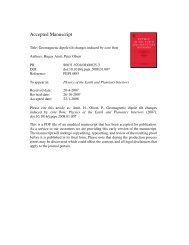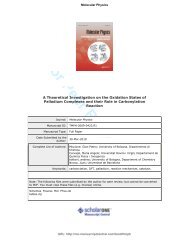WHAT IS THE BEST MEASURE OF EMPLOYMENT AND ... - TARA
WHAT IS THE BEST MEASURE OF EMPLOYMENT AND ... - TARA
WHAT IS THE BEST MEASURE OF EMPLOYMENT AND ... - TARA
Create successful ePaper yourself
Turn your PDF publications into a flip-book with our unique Google optimized e-Paper software.
opportunities are unaware of the fact - and the extent of discouragement if<br />
probably better measured through analysis of the sensitivity of participation to<br />
demand and other factors More generally, few decisions in relation to<br />
participation, employment and hours of work (both demanded and supplied)<br />
are taken other than in the context of the return to employment and of other<br />
income Without linked data on individual and household financial<br />
circumstances, the explanatory power of the LFS is inevitably limited<br />
Paddy Teahon I would like to join Terry Corcoran in thanking Donal Garvey for<br />
his excellent paper and in seconding the vote of thanks to that effect I found<br />
the paper extremely interesting as I am sure all here this evening did I believe<br />
that it shows the usefulness of the Labour Force Survey in generating<br />
information for policy purposes<br />
I should say that I see myself speaking tonight in my capacity as a member of<br />
the National Statistics Board<br />
I would like to talk briefly about three different aspects of the paper or three<br />
ways in which the paper impinges on other policy related issues of the<br />
employment and unemployment situation<br />
the differences between statistics derived from administrative records in<br />
the employment and unemployment area such as the Live Register and<br />
purpose designed statistics such as the Labour Force Survey I believe<br />
there is an important issue of avoiding confusion in the general release<br />
of statistics in this area<br />
the policy uses to which statistics on employment and unemployment<br />
are put and the consequences of what Donal Garvey has had to say<br />
here this^evening<br />
a few brief comments on the future of work and the implications of that<br />
for statistics on employment and unemployment<br />
I believe that, because statistics derived from administrative records become<br />
available earlier and more frequently than those from purpose designed<br />
surveys, these are what are seen to be, and generally accepted as, the<br />
employment and unemployment statistics The Live Register figures are<br />
published each month and are derived without reference to the nature of the<br />
unemployment in question They represent an aggregate view of<br />
unemployment and are generally interpreted in terms of the trend they disclose<br />
rather than the precise level of the different components within them<br />
Unemployment statistics derived from the Labour Force Survey become<br />
available on a much less regular basis, currently once a year, and with a<br />
significant time lag after the date to which they refer The reality is that few<br />
people, outside of those specifically involved in their work or research in this<br />
area, are aware that there is not a one for one correspondence between<br />
statistics from the Labour Force Survey and those from the Live Register I<br />
230
















